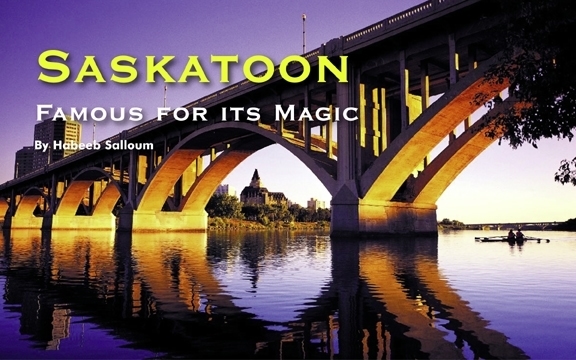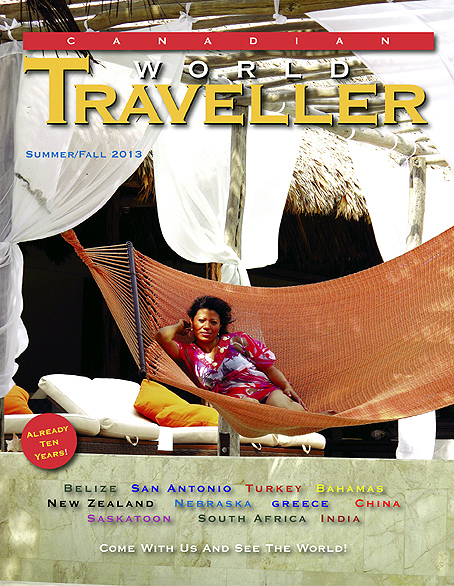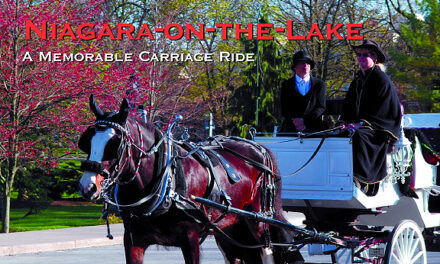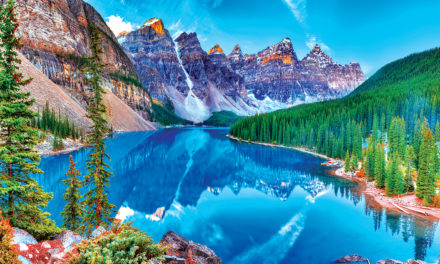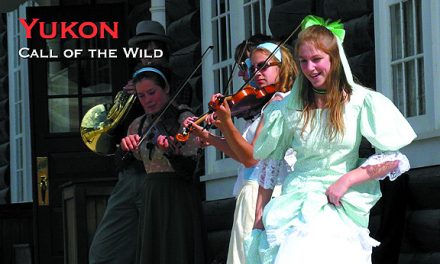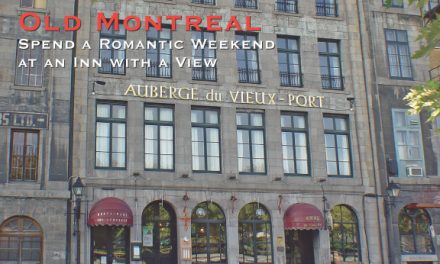Saskatoon
Famous for its Magic
Published in the Summer 2013 Issue of Canadian World Traveller
By Habeeb Salloum
 “Welcome to Saskatoon the ‘Paris of the prairies’”, the guide’s voice thundered through the tour bus. He continued, “Saskatoon is magic! If you haven’t already, soon you will be ensnared with its magic.” I looked around to see most of the passengers smiling, apparently thinking that the guide was exaggerating.
“Welcome to Saskatoon the ‘Paris of the prairies’”, the guide’s voice thundered through the tour bus. He continued, “Saskatoon is magic! If you haven’t already, soon you will be ensnared with its magic.” I looked around to see most of the passengers smiling, apparently thinking that the guide was exaggerating.
Yet, what I was to find in the next few days as I explored this modern urban centre surrounded by nature’s beauty, was that his words had a ring of truth. Flat lush farmland, embrace the city on all sides in an emerald halo. Inside its boundaries, the numerous parks and the South Saskatchewan River with its tree-lined banks dividing the town in two, give Saskatoon an impressive aura. One of the sunniest cities in Canada, it is known as the ‘city of bridges’ due to the seven bridges that span its river. A jewel set in the heart of Canada’s prairies it is one of Canada’s most beautiful cities, especially during the summer months.
Saskatoon was founded in 1882 and got its name from the Cree misaskwatomin, a Cree name for the succulent bluish-red berries that grow wild and are found in profusion in the surrounding countryside. From a tiny outpost, the city evolved to become a booming urban centre. Today, its imposing buildings and landscaped suburbs with their modern shopping malls are a reflection of how much Saskatoon has been transformed in the intervening years.
With a population of some 285,000, it is Saskatchewan’s largest city and a centre of commerce, education and industry; as well as, besides agriculture products, two-thirds of the world’s recoverable potash. In addition, the largest deposits of uranium are in found in the Saskatoon region. With its educational institutions, edging rich farmland and thriving industry, Saskatoon is considered to be the hub of the Province of Saskatchewan.
However, this wealth has not overwhelmed the prairie spirit of small-town friendliness. Visitors are welcomed with open arms and pleasantry not only in tourist establishments but, everywhere in the city. This is best reflected during the festivals with their flair for revelry, mostly held during the summer months. Among the most important of these events are the t three-day Folkfest in August with its pavilions of cultural displays, ethnic foods and entertainment representing Saskatchewan’s cultural heritage; the May Vesna Festival called the world’s largest Ukrainian cabaret, which showcases an exotic atmosphere with Ukrainian crafts, food and non-stop entertainment; and the Saskatoon Harvest Fest, a get-together to celebrate the harvest season with traditional meals, parades, entertainment, street fair music and dancing.
While attending one of these or the many other festivals, visitors can, at the same time, explore the city’s tourist sites, most importantly, Wanuskewin Heritage Park, which has become synonymous with the city. Derived from the Cree word, wah-nus-kay-win, Wanuskewin, meaning ‘seeking peace of mind’, has been a sacred place for the First Nations Peoples for 6,000 years.
Located on the west bank of the South Saskatchewan, some 5 km (3 mi) north of the city, it is a place where the descendants of the Northern Plains Indians have re-established on a 116 ha (300 ac) plot of land a sense of harmony with nature, revolving around the bison. All summer long, dances, songs, storytelling, and a variety of demonstrations and celebrations take place. Here, a visitor can also learn how to bake bannock, build a tepee and tan a hide.
After the experience with the history of the Indigenous Peoples, visitors would do well to tour the University of Saskatchewan, one of the most impressive educational institutions in Canada. Established in 1909 on a 2,550-acre site, the university with its more than 25,000 full time and 8,600 part time students is one of the great learning institutions in the country. The Gothic style of the early edifices and the grey and Tyndall stone buildings of campus structures, set in a tree-filled landscape and edged by the South Saskatchewan River, usually leaves a lasting impression on visitors.
When travellers tire of tourist sites, there is the fine dining to be found in the city. Varied eating places saturate the heart of town. Besides hearty prairie fare a wide range of ethnic foods are offered – from Greek and Ukrainian to Chinese and East Indian. Enhancing the food establishments is the lively entertainment to be found in hotel bars, nightclubs and theatres. In the words of our guide, “A traveller often as not is usually entrapped in Saskatoon’s magic and will always yearn to return and revel in its pleasures.”

